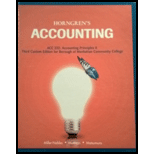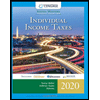
ACCOUNTING PRINCIPLES 222 5/16 >C<
2nd Edition
ISBN: 9781323461525
Author: Horngren
Publisher: PEARSON C
expand_more
expand_more
format_list_bulleted
Textbook Question
Chapter 1, Problem 8RQ
A business purchases an acre of land for $5,000. The current market value is $5,550, and the land was assessed for property tax purposes at $5,250. What value should the land be recorded at, and which accounting principle supports your answer?
Expert Solution & Answer
Want to see the full answer?
Check out a sample textbook solution
Students have asked these similar questions
1) Identify whethere the company is paying out dividends based on the attached statement.
2) Describe in detail how that the company’s dividend payouts have changed over the past five years.
3)Describe in detail the changes in “total equity” (representing the current “book value” of the company).
Which is not an objective of internal controls?A. Safeguard assetsB. Improve profitsC. Ensure accurate recordsD. Promote operational efficiencyneed help
Which is not an objective of internal controls?A. Safeguard assetsB. Improve profitsC. Ensure accurate recordsD. Promote operational efficiencyno ai
Chapter 1 Solutions
ACCOUNTING PRINCIPLES 222 5/16 >C<
Ch. 1 - Prob. 1QCCh. 1 - Which of the following is not an external user of...Ch. 1 - Prob. 3QCCh. 1 - Prob. 4QCCh. 1 - Prob. 5QCCh. 1 - Which of the following requires accounting...Ch. 1 - At the end of a recent year, Global Cleaning...Ch. 1 - Consider the overall effects on Global Cleaning...Ch. 1 - Assume that Global Cleaning Service performed...Ch. 1 - The balance sheet reports the Learning Objective 5...
Ch. 1 - Assume Global Cleaning Service had net income of...Ch. 1 - What is accounting?Ch. 1 - Prob. 2RQCh. 1 - Prob. 3RQCh. 1 - Prob. 4RQCh. 1 - Prob. 5RQCh. 1 - Prob. 6RQCh. 1 - Prob. 7RQCh. 1 - A business purchases an acre of land for $5,000....Ch. 1 - What does the going concern assumption mean for a...Ch. 1 - Which concept states that accounting information...Ch. 1 - Financial statements in the United States are...Ch. 1 - Prob. 12RQCh. 1 - What is the accounting equation? Briefly explain...Ch. 1 - What are two ways that equity increases? What are...Ch. 1 - How is net income calculated? Define revenues and...Ch. 1 - What are the steps used when analyzing a business...Ch. 1 - List the four financial statements. Briefly...Ch. 1 - What is the calculation for ROA? Explain what ROA...Ch. 1 - Prob. S1.1SECh. 1 - Determining organizations that govern accounting...Ch. 1 - Identifying types of business organizations...Ch. 1 - Prob. S1.4SECh. 1 - Applying accounting assumptions and principles...Ch. 1 - Prob. S1.6SECh. 1 - Prob. S1.7SECh. 1 - Identifying accounts Learning Objective 3 Consider...Ch. 1 - Prob. S1.9SECh. 1 - Using the accounting equation to analyze...Ch. 1 - Identifying accounts on the financial statements...Ch. 1 -
I rhr JoUou'ing ittfonnatioH to antovr Short...Ch. 1 -
I rhr JoUou'ing ittfonnatioH to antovr Short...Ch. 1 - Irhr JoUou'ing ittfonnatioH to antovr Short...Ch. 1 - Prob. S1.15SECh. 1 - Prob. S1.16SECh. 1 - Prob. E1.17ECh. 1 - Prob. E1.18ECh. 1 - 1. Accounting equation a. An economic resource...Ch. 1 - Prob. E1.20ECh. 1 - Prob. E1.21ECh. 1 - Prob. E1.22ECh. 1 - Prob. E1.23ECh. 1 - Prob. E1.24ECh. 1 - Using the accounting equation to analyze...Ch. 1 - Using the accounting equation to analyze business...Ch. 1 - Using the accounting equation to analyze business...Ch. 1 - Using the accounting equation to analyze business...Ch. 1 - Prob. E1.29ECh. 1 - Preparing the financial statements Learning...Ch. 1 - Prob. E1.31ECh. 1 - Prob. E1.32ECh. 1 - Use the following information to answer Exercises...Ch. 1 - Prob. E1.34ECh. 1 - Prob. E1.35ECh. 1 - Prob. E1.36ECh. 1 - Prob. E1.37ECh. 1 - Prob. E1.38ECh. 1 - Prob. E1.39ECh. 1 - Prob. P1.40APGACh. 1 - Prob. P1.41APGACh. 1 - Prob. P1.42APGACh. 1 - Prob. P1.43APGACh. 1 - Prob. P1.44APGACh. 1 - Prob. P1.45APGACh. 1 - Prob. P1.46APGACh. 1 -
Astm
< ->»l 1 • ptl « I Sb
•ArtA* V...Ch. 1 - Prob. P1.48BPGBCh. 1 - PI »9K Preparing financial »uifmrnn I’kvx-nii.i...Ch. 1 - PI-SOB Preparing financial italtmmu Precision Pies...Ch. 1 - Prob. P1.51BPGBCh. 1 - Prob. P1.52BPGBCh. 1 - 1*1 S 4H I *it»g the jsi nmn|i equation foi...Ch. 1 - || V. , -
«••••"“ -
4 «k»wl Ml*«...Ch. 1 - Decision Case 1-1 Let’s examine a case using...Ch. 1 - The tobacco companies have paid billions because...Ch. 1 - Prob. 1.1FCCh. 1 - Prob. 1.1FSC
Knowledge Booster
Learn more about
Need a deep-dive on the concept behind this application? Look no further. Learn more about this topic, accounting and related others by exploring similar questions and additional content below.Similar questions
- Can you solve this general accounting problem using appropriate accounting principles?arrow_forwardWhich is not an objective of internal controls?A. Safeguard assetsB. Improve profitsC. Ensure accurate recordsD. Promote operational efficiency no aiarrow_forwardPlease provide the accurate answer to this financial accounting problem using appropriate methods.arrow_forward
- Please provide the correct answer to this financial accounting problem using valid calculations.arrow_forward20 Nelson and Murdock, a law firm, sells $8,000,000 of four-year, 8% bonds priced to yield 6.6%. The bonds are dated January 1, 2026, but due to some regulatory hurdles are not issued until March 1, 2026. Interest is payable on January 1 and July 1 each year. The bonds sell for $8,388,175 plus accrued interest. In mid-June, Nelson and Murdock earns an unusually large fee of $11,000,000 for one of its cases. They use part of the proceeds to buy back the bonds in the open market on July 1, 2026 after the interest payment has been made. Nelson and Murdock pays a total of $8,456,234 to reacquire the bonds and retires them. Required1. The issuance of the bonds—assume that Nelson and Murdock has adopted a policy of crediting interest expense for the accrued interest on the date of sale.2. Payment of interest and related amortization on July 1, 2026.3. Reacquisition and retirement of the bonds.arrow_forward13 Which of the following is correct about the difference between basic earnings per share (EPS) and diluted earnings per share? Question 13 options: Basic EPS uses comprehensive income in its calculation, whereas diluted EPS does not. Basic EPS is not a required disclosure, whereas diluted EPS is required disclosure. Basic EPS uses total common shares outstanding, whereas diluted EPS uses the weighted-average number of common shares. Basic EPS is not adjusted for the potential dilutive effects of complex financial structures, whereas diluted EPS is adjusted.arrow_forward
arrow_back_ios
SEE MORE QUESTIONS
arrow_forward_ios
Recommended textbooks for you
 Individual Income TaxesAccountingISBN:9780357109731Author:HoffmanPublisher:CENGAGE LEARNING - CONSIGNMENT
Individual Income TaxesAccountingISBN:9780357109731Author:HoffmanPublisher:CENGAGE LEARNING - CONSIGNMENT





Individual Income Taxes
Accounting
ISBN:9780357109731
Author:Hoffman
Publisher:CENGAGE LEARNING - CONSIGNMENT
IAS 29 Financial Reporting in Hyperinflationary Economies: Summary 2021; Author: Silvia of CPDbox;https://www.youtube.com/watch?v=55luVuTYLY8;License: Standard Youtube License